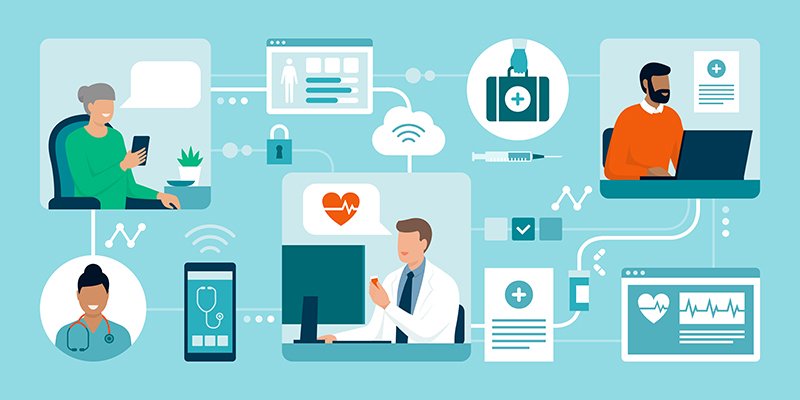Australian healthcare has an opportunity to change the way we treat patients. We can put them at the centre of the system and in doing so dramatically improve health outcomes. Australia has a fragmented healthcare system where mistakes cost lives and hundreds of millions of dollars every year. Mistakes that we can prevent using technology that already exists.
The government’s flagship approach to innovation in healthcare is My Health Record, which is deeply flawed, costly, and based on out-of-date technology. We can, and should, expect better. Effective tools already exist, but government inaction stymies true, meaningful, big picture innovation in healthcare.
Imagine having a heart arrhythmia that is detected by your smartphone, a risk calculation is completed by Artificial Intelligence (AI) and you are alerted that you should attend your doctor, who has immediate access to the smart device recording and can instigate the best treatment tailored to your unique genetic makeup and treatment preferences. This is going to happen and happen sooner than you realise.

The dangers of fragmented healthcare
It is estimated that harm occurs in about one in 50 primary care consultations and substantial harm may occur in about one in 20. It is also estimated that five-10 per cent of patients admitted to hospital suffer harm related to their healthcare. Each year in Australia there are more than two million adverse drug events, with about 250,000 of these leading to hospitalisation. This costs the country approximately A$1.4billion annually. Tragically, there are over 2,000 deaths each year in Australia related to medication errors.
The Organization for Economic Co-operation and Development (OECD) has noted Australia pays more for primary care than many comparable countries, but has worse patient outcomes. This is partly due to silos within healthcare. This is one of the most significant challenges facing Australian healthcare. We need to break down these silos and help clinicians work together more effectively. Making it easy to exchange healthcare data securely is key to having a more efficient and safer healthcare system. If patients have control over their own healthcare data they can provide it to healthcare providers at the appropriate time.
Some 47 per cent of Australian patients have more than one GP, those who attend a single practice have lower total visits (4.6 vs 6.9 per annum). Of patients attending primary care, 70 per cent are prescribed a medication at least once. There are multiple risks when prescribing medications including interactions with other medications, contra-indications due to patient factors, dose-related factors and use of appropriate monitoring. Many of these risks can be effectively managed using data that is already collected within electronic patient medical records. However, clinicians need to have timely access to complete and accurate healthcare records.
Furthermore, we need to move from collecting data to sharing and analysing data. We need to be able to prevent problems rather than simply reacting to them, particularly when they’re predictable.
Reducing these errors and risks will significantly improve healthcare outcomes whilst reducing costs. This will also improve patient experiences and quality of life, and improve clinician satisfaction, enabling them to provide the high-quality care they wish to provide.
Putting patients in control
One of the seven strategic priority outcomes of the National Digital Health Strategy is that health information should be available whenever and wherever it is needed. My Health Record relies on organisations and clinicians uploading data, which may not happen in busy clinics. It contains data that is not readily searched for relevant information. We need real-time data that can be utilised in decision making by clinicians. If patients have control, they can be partners in making healthcare decisions.
Our solution is a healthcare system that puts the patient at the centre, with patients owning their health data and taking it with them to all their healthcare providers. In our vision, patients will be able to upload their data from their smartwatches or from their home monitors to supplement the data uploaded by their healthcare providers to give doctors and patients more accurate and robust data. Patients need to be in control of their healthcare data and able to keep it all in one place – in the cloud. Cloud-based storage means the data is accessible from anywhere in Australia.
Government action is needed particularly around data privacy and stewardship. Other countries such as the US are a long way ahead of Australia, they have systems where real-time patient data is shared, analysed, and acted upon. A good example of this is Ochsner Health in Louisiana where pregnant women are remotely monitored to spot emerging problems and brought in to see clinicians when the system spots a problem.
We need to develop Australian-based systems that fit with how our healthcare system works. This will take government engagement and funding. We need our data systems to be Fast Healthcare Interoperability Resources (FIHR) compliant. FIHR is a system created by an Australian, Graham Grieve, but more likely to be found in action in the US. Using FIHR enables efficient sharing of data and breaks down those silos that Australian healthcare has created.
Patient engagement leads to better outcomes
How can patients be more engaged with their own health? Individuals who are more engaged with their own care have better outcomes. There is plenty of evidence that patients who have more control over their healthcare data and subsequently more control over their healthcare decisions are better engaged and experience much better health outcomes than those who are passive consumers of healthcare.
We anticipate the use of cloud-based data analytics to spot those at risk and act before they develop medical conditions or complications of existing conditions. Systems that monitor, predict, and give feedback, encouragement, and incentives to patients are the future of healthcare. They should improve knowledge and empower patients. Doctors need to feel comfortable using these systems, they need to know they are safe and lead to better patient outcomes. This will take time; it will also require robust evidence.
Can we give people more control over their healthcare and healthcare data? A seminal study by Basch et al showed that cancer patients who track symptoms and share this with their doctors experience a better quality of life, have fewer visits to the emergency department and live longer.
Participatory healthcare
Decision-making by patients should be encouraged with effective feedback and enabling them to know when to seek help and when it is okay not to. Participatory healthcare (a term created by Hood and Aufray in 2013) values the inputs of patients; it is the first step to providing truly individualised healthcare. Patients can carry with them their own normal values or critical values and be advised what to do when significant variations occur.
This doesn’t take away responsibility from patients regarding decision-making but empowers them to know when and how to act. Doctors can also benefit from these systems, having more complete data about a patient, having AI algorithms screen patients for serious conditions and safety issues. These algorithms have been shown to improve diagnostic and treatment accuracy.
Research translation
A perennial problem is translating relevant research into normal medical practice. Efficient translation from medical research to medical practice can reduce the costs of medical innovation and improve patient outcomes.
A benefit of cloud-based big data sets with AI tools is that new knowledge from researchers can be incorporated into feedback to patients, reducing the current lengthy translation time from research to practice. Being able to widely disseminate the most effective treatment options will decrease variability in quality of care. This has the potential to reduce current inequalities in healthcare.
Our proposed solution breaks down silos of medical data to deliver better outcomes for patients and staff. We seek to use AI, big data analytics, deep learning, clinical decision support systems and communication tools to enable effective collaboration across all healthcare sectors to deliver cost-effective, safer, and more personalised care. We need patients to be active in their own healthcare and have the support they need to do this.
We need the support of government to make this happen, we need clarity on who owns healthcare data and how it can be used, shared, and protected.
Dr Julian Hick is a co-founder of Discovery Healthcare, a company that aims to improve patient care through the use of digital technology and data analysis. He’s also a General Practitioner (GP) currently working in Perth. Prior to becoming a doctor, he was an academic working on socio-economic regeneration and equality and has taught undergraduates and postgraduates on how to understand and utilise data and statistics to improve patient care. He’s also published a book on applying research and statistics for GPs and papers analysing data to identify the best patient care models.
Footnotes
Green. J, et al: When patient activation levels change, health outcomes and costs change too. Health Affairs 2015 34(3): 431-437
Basch et al: Overall survival results of a trial assessing patient-reported outcomes for symptom monitoring during routine cancer treatment. JAMA 2017 318(2): 197-198
Hood, L. and C. Auffray. Participatory medicine: a driving force for revolutionising healthcare. Genome Medicine. 2013 4(110)
Do you know more? Contact James Riley via Email.

